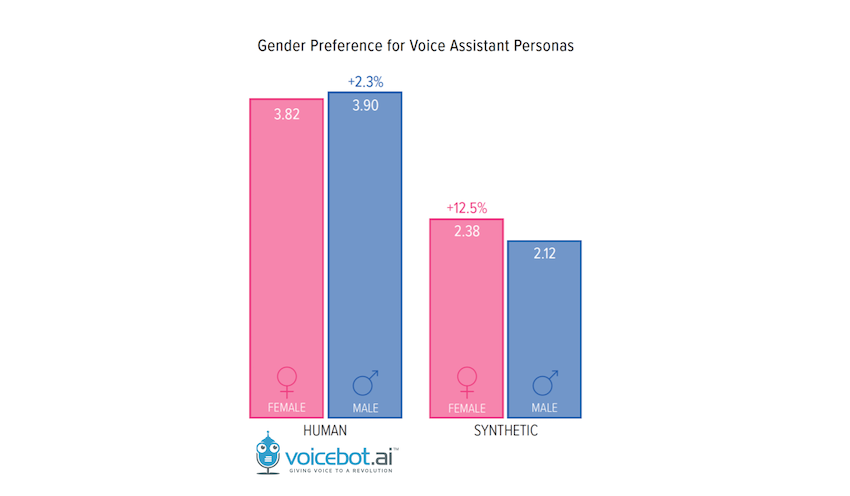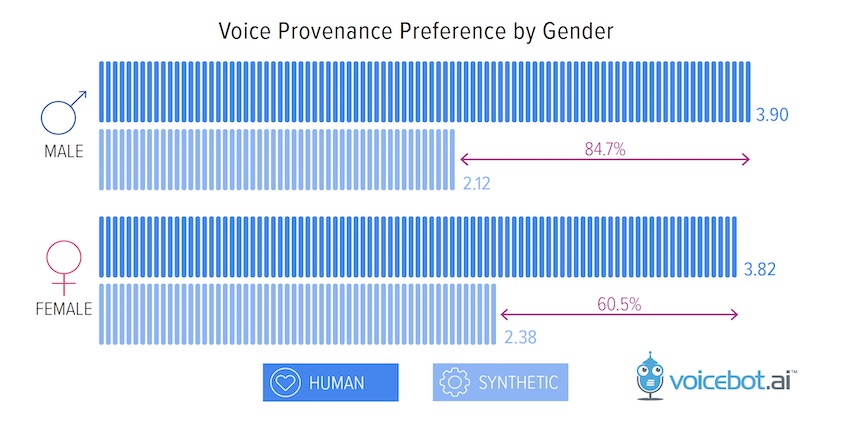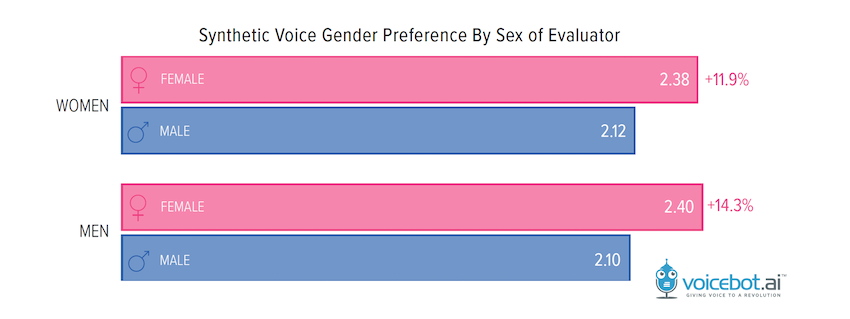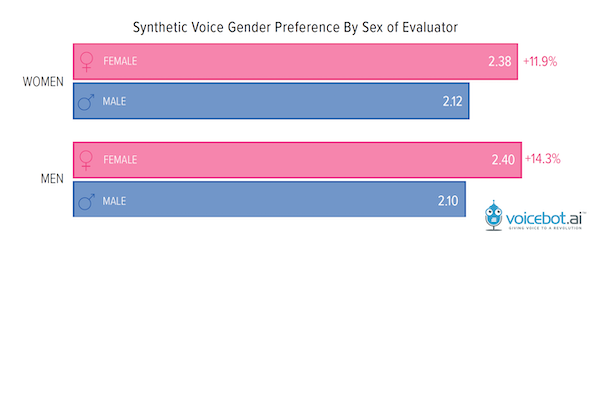U.S. Consumers Do Express a Preference for Female Gendered Voice Assistants According to New Research
There are intermittent discussions within the voice technology community and in the media about the gender of popular consumer voice assistant voices and what drove the decision around voice persona selection. We variously hear that the decisions were based on consumer preferences during testing, brand strategy, and sexism. Even a U.N. body weighed in on the latter point.
Dag Kittlaus, a co-founder behind Apple’s Siri and Viv Labs which is the technology underpinning Samsung’s Bixby assistant, commented on the sexism criticism in a Twitter post earlier this year saying, “Siri was genderless from the beginning. Different countries had different voice defaults…male and female. Everything is configurable.”
I call BS on this. Siri was genderless from the beginning. Different countries had different voice defaults…male and female. Everything is configurable. Just think this perspective is pushing it. https://t.co/7YnH4UE05Y
— Dag Kittlaus (@Dagk) June 1, 2019
Whatever the reasons behind a voice assistant’s implicit gender, the selection does influence perception. We aren’t in a position to comment today on why companies with assistants chose their voice persona genders beyond official corporate statements. However, we did think we could measure consumer preference. Voicebot collaborated with Voices.com and Pulse Labs to capture consumer sentiment around a number of voice user experience factors ranging from preferences for human versus synthetic voices to tolerance for the duration of voice assistant dialogue. One set of tests focused on consumer reaction to voices of different genders. The results are published in a new report titled, What Consumers Want in Voice App Design 2019.
A Measurable Preference for Synthetic Female Voices
Our panel of 240 testers heard two female voices and two males voices in the study. One synthetic and one human voice were presented for each gender and testers were asked to evaluate the voices on a 1-5 scale. The synthetic voices were ranked lower than the human voices as earlier reported data revealed. However, the synthetic female voice received 12.5% higher ratings than the synthetic male voice.

Interestingly, we see that the human male voice was rated 2.3 % higher than the human female. This suggests the gendered voice preference may vary based on whether the voice is human or synthetic. Given the sample size of 240, it is also fair to say the results from the human voice evaluations fall within the margin of error for the test while the results for the synthetic voices do not.
We also see the greater preference for female synthetic voices when comparing them to their human counterparts. The consumer testers expressed clear preferences for human voices over synthetic, but the difference in their preferences was less for female than male-gendered voices.

The male human voice received an average score of 3.90 compared to its synthetic counterpart’s result of 2.12. That is almost an 85% difference in ranking. By contrast, the difference in the human and synthetic female voices was only 60.5%. This could be viewed as a higher tolerance for synthetic voices when they are female-gendered.
Women and Men Agree
It is also worthwhile to note that both women and men expressed higher preferences for female-gendered synthetic voices. Women reported an 11.9% higher preference for synthetic female voices compared to similar male-gendered voices. Men expressed a slightly higher difference in preference at 14.3%.

There could be many reasons for these differences. It could be the familiarity of the U.S.-based consumer panel where voice assistants have tended to have a default female voice or only a female voice option. A future test in another country where most voice assistants have historically had a male-gendered voice might shed more light on this variable. There could also be cultural differences in countries outside the U.S. that contribute to alternate results.
We also noticed that the preference for female synthetic voices was greater among participants over the age of 60. This could be impacted by cultural norms that differ among generations or potentially based on experience. Many people in this older age group will be familiar with the Stanley Kubrick movie “2001: A Space Odyssey,” released in 1968. The film included the ominous and predatory HAL 9000 voice assistant which could also make some consumers more wary of male-gendered voices used in assistants. HAL 9000 is virtually opposite in personality type to the more cheerful Siri or Alexa.
Does the Voice Assistant’s Gender Matter?
Social commentators can debate how a voice assistant’s gender impacts or reflects societal norms and biases. That is not our focus here. The question for many voice app developers is how does a decision such as voice assistant gender impact user experience. A critical review of the data suggests female synthetic voices are more likely to be perceived favorably than male voices, but the difference is by no means decisive. There were certainly many evaluators in the study that ranked the synthetic male voice more favorably. So, given the narrowness of the difference, other factors such as brand or product strategy are likely to have a greater impact on user experience.
Amazon applied these principles to choosing Alexa’s voice before its launch in 2014. In a 2018 interview with Business Insider, Daniel Rausch, vice president of smart home for Amazon commented, “We carried out research and found that a woman’s voice is more ‘sympathetic’ and better received.” The same article cited an Amazon spokesperson expanding on Rausch’s comment by saying, “In choosing the voice, Amazon was careful to bring the most ‘pleasing’ sounding voice into people’s living rooms — after many trials, Alexa’s was the one to come out on top.”
A Microsoft spokesperson expressed a similar sentiment to a Wall Street Journal reporter in 2014 saying, “For our objectives—building a helpful, supportive, trustworthy assistant—a female voice was the stronger choice.” Earlier this month, Microsoft announced Cortana will have a male voice option. Andrew Shuman, a vice president at Microsoft, told VentureBeat in an interview, “Certainly, we heard … a lot … that our users wanted this option, and that was the really big push to get it done. And you’re absolutely right, it’s been a story for a while.”
Apple’s Siri and Google Assistant have had both female and male options for years and Samsung’s Bixby has both male and female options. Amazon and Microsoft were the holdouts of having only a female-gendered voice assistant until this year. While Amazon has made no indications to date of a male voice option for Alexa, it did announce the forthcoming introduction of a synthetic version of Samuel L. Jackson’s voice. That means there will soon be a male option for Alexa-enabled devices in the U.S.
With that said, Voicebot’s research, conducted in collaboration with Voices.com and Pulse Labs, supports these original assertions about consumer preferences by Amazon and Microsoft executives. And, these findings also correlate with data published in 2011 by researchers at Indiana University and earlier studies on these topics. Consumers do express a measurable preference for female over male synthetic voices. However, the difference is not overwhelming so voice app developers and voice assistant providers should feel confident in choosing whatever voice option fits best with their product strategy.
You can download the entire report here: Download Report
Follow @bretkinsella Follow @voicebotai
Samuel L. Jackson is Alexa’s First Celebrity Voice, But it Will Cost You a Dollar









